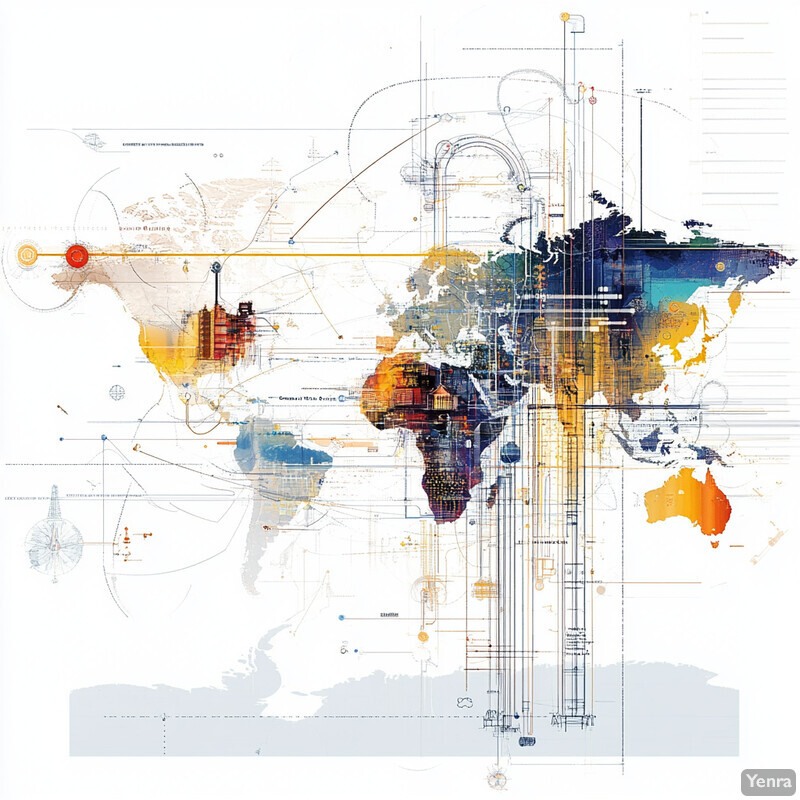1. Real-Time Monitoring of Regulations
Compliance teams benefit from AI-driven real-time monitoring that keeps them continuously informed of new laws and regulatory updates. By automatically scanning government websites, bulletins, and industry portals, AI systems can catch changes the moment they occur. This immediacy allows organizations to respond faster to evolving requirements, minimizing the window of non-compliance. The approach transforms a traditionally manual, periodic task into a proactive, ongoing process. As a result, companies can maintain an up-to-date compliance posture and avoid being caught off guard by regulatory shifts.

The sheer volume of regulatory changes has made manual tracking impractical – financial institutions faced an average of 185 regulatory updates per day in 2023. AI platforms address this challenge by providing real-time alerts and analysis of those updates. For example, modern compliance tools leverage machine learning to continuously monitor regulatory feeds and immediately flag relevant changes. A 2024 industry report noted that integrating AI for real-time regulatory change management enabled firms to automate monitoring and responses to new rules as they emerge. This continuous oversight helps organizations stay ahead of the curve. In practice, companies using AI-driven regulatory monitoring report far fewer instances of overlooked rule changes and can implement required compliance measures much more quickly than before. The net effect is a more agile compliance function that keeps pace with a regulatory environment growing “over 500%” more complex than a decade ago.
2. Automated Document Analysis
AI greatly streamlines the review of contracts, policies, and other legal documents by automating their analysis. Instead of relying on paralegals or compliance officers to painstakingly read through hundreds of pages, natural language processing algorithms can rapidly interpret text and identify key clauses or risks. This automation improves both speed and consistency – routine errors or omissions that a human might miss are caught by the machine. In practice, automated document analysis means organizations can ensure all their contracts and internal policies are compliant with current regulations without an overwhelming manual effort. The significance is a dramatic boost in efficiency and accuracy in legal compliance reviews.

Recent data showcases the impact of AI on legal document review efficiency. In a 2024 Gartner survey, 62% of legal teams reported that AI significantly improved their ability to detect non-compliant clauses in contracts, versus traditional review methods. By automatically flagging risky or out-of-date language, AI tools help humans focus on problem areas. Companies using AI-assisted contract analysis also saw major time savings – on average, organizations saved 12 hours per contract review cycle by automating routine checks and comparisons. Additionally, industry benchmarks indicate that AI can accelerate contract review by as much as 40%, by quickly standardizing clauses and spotting inconsistencies that would take humans far longer to find. These efficiencies translate into tangible benefits: one report noted that deploying AI for document and contract analysis could save large firms the equivalent of $100,000 in lawyer hours per year per employee by streamlining review workflows. Overall, the evidence shows that automated analysis not only catches more potential compliance issues but does so in a fraction of the time of manual review.
3. Predictive Compliance Risk Assessment
By examining historical data and patterns, AI can predict where future compliance breaches are most likely to occur. This predictive compliance risk assessment shifts the approach from reactive to proactive. Machine learning models digest past incidents, audit findings, and operational trends to assign risk scores or forecast potential violations. Compliance officers can then focus on high-risk areas before problems materialize – for example, strengthening controls in a department that the model indicates has an elevated risk of a policy violation. The significance of this capability is that organizations can allocate resources more strategically and mitigate issues in advance, reducing the chance of costly compliance failures.

Recent studies confirm that predictive analytics can markedly improve compliance outcomes. In the pharmaceutical sector, companies using AI-driven risk modeling reported a 40% reduction in compliance violations and a 25% decrease in audit findings after implementing predictive compliance analytics. These models, often based on techniques like Bayesian networks, learn from past compliance performance to flag subtle warning signs. Research has also demonstrated the accuracy of such tools – one 2023 study showed that machine learning algorithms trained on enforcement data could predict regulatory enforcement priorities with over 85% accuracy. This level of precision means organizations can identify which behaviors or processes are likely to draw regulator attention. In practice, predictive risk scoring has allowed compliance teams to take preemptive actions (such as extra training or audits in vulnerable areas), leading to fewer incidents and demonstrating a forward-looking compliance program to regulators. Notably, Deloitte’s 2023 survey found data-driven compliance programs (which include predictive elements) saw a 30% drop in compliance costs as well – a testament to the efficiency gains when potential issues are caught early rather than after the fact.
4. Anomaly Detection in Transactions
AI excels at detecting unusual patterns in financial transactions and records that could indicate compliance issues such as fraud, money laundering, or accounting irregularities. By learning what “normal” behavior looks like, machine learning algorithms can flag anomalies – transactions that are out of pattern for a customer, or entries that deviate from typical accounting practice – in real time. This automated scrutiny vastly increases the chances of catching illicit or non-compliant activity early. For compliance teams, anomaly detection means less reliance on random audits and more systematic oversight. It serves as a continuous watchdog, identifying suspicious activities that warrant investigation before they escalate into major violations.

Financial institutions have reported dramatic improvements by using AI for anomaly detection. HSBC, for example, implemented an AI-powered system to monitor over a billion transactions a month and saw it identify 2–4 times more potential financial crimes than prior methods, while reducing false alarms by 60%. This indicates that the AI is not only catching more real issues, but it’s also more accurate in avoiding benign transactions. The precision of such systems directly addresses a longstanding compliance pain point: false positives. Traditional rules-based monitoring triggers many alerts that turn out to be legitimate activity, consuming time. AI’s ability to learn context – distinguishing truly suspicious anomalies from normal outliers – means investigators can focus on fewer, more credible red flags. Banks have also noted efficiency gains; for instance, HSBC reported that AI analysis cut the processing time for reviewing transactions from “several weeks to a few days”. These results underscore that anomaly detection driven by AI not only strengthens compliance by catching what humans might miss, but also streamlines operations by drastically reducing noise and investigation workload.
5. Contextual Understanding of Regulatory Language
Modern AI language models can parse complex legal and regulatory language in context, much like a legal expert would. This contextual understanding means that AI doesn’t just look at keywords in a law or policy – it grasps the meaning of clauses within the broader document and legal framework. For compliance, this is crucial: regulations often hinge on nuanced phrasing or definitions that require interpretation. AI trained on legal data can interpret such nuances and even reconcile different terminology that refers to the same concept. The significance is a reduction in misinterpretation of requirements. Organizations can rely on AI to clarify what a regulation is actually demanding, helping ensure that internal policies truly align not just with the letter, but the intent of the law.

Advances in natural language processing (NLP) have significantly improved AI’s ability to handle legal texts. Research in 2024 noted that large language models fine-tuned for the legal domain enhance the efficiency and precision of legal analysis, outperforming older rule-based systems in understanding statutes and contracts. These AI models leverage their training on vast legal corpora to catch subtleties – for example, distinguishing between “shall” and “may” in obligations, or picking up implied requirements that a literal reading might miss. Big Four firms are already applying this technology: Deloitte reported that generative AI systems enable compliance teams to ask questions of verbose regulations and get answers with cited sources, drilling down to the relevant parts of lengthy texts. In practice, such an AI might allow a user to query, “What are the data retention requirements in the new law?” and get a precise answer pointing to the clause, rather than combing through pages of legalese. This depth of contextual comprehension reduces the chance of misapplying a rule due to misunderstanding. It effectively gives organizations an always-on “digital legal advisor” that can interpret complex requirements across different contexts and jurisdictions with a high degree of accuracy, thereby strengthening compliance alignment.
6. Continuous Policy Update Integration
AI enables a continuous integration between external regulatory changes and internal company policies. Traditionally, when a new law is passed or a rule changes, compliance officers must manually update corporate handbooks, procedures, and checklists – a process that can be slow and prone to omissions. With AI, this update cycle becomes automatic. The AI “reads” the new regulation, identifies which sections of the company’s policies are affected, and suggests or even applies updates in those documents. The result is that internal compliance documentation is always in sync with the current law. This seamless integration significantly reduces lag time between a regulatory change and corporate compliance with that change. It also relieves the burden on compliance staff to constantly rewrite policies, freeing them to focus on higher-level risk management.

Organizations have started using AI-driven tools that connect the regulatory knowledge base to their policy management systems. One RegTech platform in 2024, for instance, uses machine learning to automatically map new or changed regulations to a firm’s internal policies and controls. As soon as a rule is amended, the system identifies relevant obligations and triggers an update of the corresponding policy document or checklist item. Deloitte has observed the power of generative AI in this area as well – AI can even draft revised policy language to comply with new requirements and present it for review. This means if a data privacy law adds a restriction, the AI might proactively insert a new clause into the company’s privacy policy reflecting that restriction. Companies employing these technologies have reported a drastic reduction in the effort and time needed for policy maintenance. Changes that once took weeks of committee review and editing can be implemented in days or hours, with AI handling the initial heavy lifting. The continuous alignment not only ensures compliance but also provides auditors and regulators clear evidence that the organization’s documented procedures are up-to-date at all times.
7. Automated Compliance Checklists
AI can automatically generate and manage compliance checklists, which enumerate all the steps or controls needed to comply with a given regulation or standard. Rather than creating checklists by hand for each new law (and updating them whenever rules change), organizations use intelligent systems that produce these lists dynamically. The AI essentially breaks down dense regulatory texts into actionable to-do items. This ensures that nothing is overlooked – every requirement becomes an item on a checklist. The checklists can also be tailored: for example, an AI might generate slightly different steps for a U.S. office versus an EU office based on local regulations. By automating this process, companies maintain comprehensive and current compliance checklists with far less effort, improving audit readiness and consistency across the board.

RegTech solutions are already delivering automated, dynamic checklists. One notable example is a financial industry platform that employs NLP to identify all applicable regulatory obligations for a business and seamlessly map them to the company’s policies, procedures, and controls. In essence, the system produces a master checklist of obligations and links each item to evidence of how the firm addresses it. When new rules come out, the AI updates this obligations inventory in near real-time. According to a 2025 case study, this approach allowed the platform’s users to isolate relevant regulatory changes and update their compliance checklists “in minutes” – a process that previously could take weeks. The AI scans the new rule, finds which checklist items are affected or missing, and revises the list accordingly. Companies utilizing such automated checklists report greater confidence during audits and inspections. Auditors can be given an AI-maintained checklist that shows every requirement and the status of the corresponding control, demonstrating a complete and up-to-date compliance program. Moreover, because the checklists are continuously refreshed, they help catch gaps that might emerge as regulations evolve, effectively preventing compliance slippage.
8. Smart Contract Validation
As businesses adopt blockchain and self-executing “smart contracts,” ensuring these digital contracts comply with laws and regulations is a new frontier for compliance. AI tools can validate smart contract code by checking its terms and execution logic against legal requirements. This might involve formal verification (mathematically proving that a contract adheres to certain rules) or scanning code for clauses that could cause regulatory breaches (for example, an automated lending contract that might violate interest rate caps). The significance is that companies can confidently deploy blockchain solutions knowing they won’t inadvertently break the law. It adds a layer of trust and safety to the innovative but sometimes risky domain of smart contracts, reducing the chances of costly legal disputes or enforcement actions related to autonomous transactions.

The importance of smart contract compliance has been underscored by high-profile incidents in the crypto world, and AI is helping to address these issues. According to industry reports, advanced AI-driven auditing of smart contracts has already proven its worth – in recent years, over $1.1 billion in digital assets were recovered or safeguarded thanks to improved detection of smart contract vulnerabilities and compliance issues. These recoveries came after incidents where flawed or non-compliant smart contracts were exploited, and subsequent AI-assisted code analyses identified the weaknesses and guided fixes or legal interventions. On a preventive front, tech firms are now deploying AI tools that analyze Ethereum and Hyperledger smart contracts before they go live, flagging any terms that might conflict with regulations (for instance, ensuring a contract’s automated payments comply with sanctions or AML rules). Early case studies show AI validation significantly reduces errors – one academic experiment in 2024 achieved near 100% accuracy in identifying non-compliant clauses in a set of test smart contracts, whereas human reviewers caught fewer issues. While formal metrics are still emerging, regulators like the U.K.’s Financial Conduct Authority have encouraged the use of such AI validation as part of robust governance for blockchain applications. This momentum suggests that AI-based compliance checks will become a standard prerequisite for smart contracts in regulated industries.
9. Sentiment and Intent Analysis in Communications
AI can monitor internal communications – emails, chat messages, call transcripts – to detect language that indicates possible unethical or non-compliant behavior. By analyzing sentiment (tone, emotion) and intent (meaning behind words), these systems flag communications that human supervisors should review. For example, an overly negative or secretive tone around a particular project might signal an employee’s intent to circumvent controls. The benefit of this technology is early detection of compliance risks that manifest in communication before they appear in actions. It helps enforce codes of conduct, prevent harassment or misconduct, and catch internal control issues (like an employee discussing a plan to bypass a procedure) at inception. Essentially, it’s a proactive way to gauge the ethical pulse of an organization.

Real-world deployments of AI communication surveillance have yielded concrete compliance protections. In the financial sector, banks have used AI text analysis to enforce insider trading rules by scanning internal chats. For instance, companies now flag any mention of earnings results or stock trades in employee messages during blackout periods, preventing improper disclosures before they happen. In one tech firm case, this AI-driven monitoring caught an employee attempting to share confidential financial results in a chat, and compliance intervened immediately – averting a potential violation. Similarly, in healthcare, an AI system monitoring emails identified instances of staff attempting to send patient information via personal email, and automatically blocked the messages – thereby preventing what would have been HIPAA breaches. These are early-warning catches that likely would have been missed until after the fact without AI. A comprehensive 2025 study of a Goldman Sachs and UBS initiative found that AI communication monitoring provided “visibility and control at scale previously unattainable,” fundamentally improving compliance outcomes by catching issues that eluded traditional methods. Importantly, advanced systems can gauge not just keywords but intent – for example, differentiating an innocent joke from genuinely harassing language, or detecting when casual mentions of a gift or favor suggest a possible bribery risk. Organizations that have implemented such AI surveillance report strengthened compliance cultures, as employees know that risky talk is likely to be noticed and addressed long before it escalates.
10. Dynamic Compliance Scoring
AI enables organizations to implement dynamic compliance scoring – essentially, real-time “credit scores” for compliance risk across departments, processes, or third parties. These scores change as underlying risk factors change. For example, if a particular business unit has a spike in incidents or control failures, its compliance risk score will rise immediately. Conversely, improved training or audit results can lower the score. This dynamic scoring gives management a constantly updated heatmap of where compliance risks are highest. It helps prioritize oversight and resources, focusing attention on red or amber zones before they turn into actual compliance failures. In short, dynamic scoring turns vast amounts of compliance data into an accessible, ongoing risk metric that guides better decision-making.

Surveys show that companies are rapidly adopting AI for risk scoring and seeing benefits in clarity and foresight. According to EY’s 2025 global risk management survey, 63% of organizations are now using or piloting AI tools for vendor risk scoring, contract analysis, and continuous monitoring as part of third-party risk management. These tools assign scores to vendors (or internal units) and update them in real time based on new data – such as adverse news, cybersecurity alerts, or regulatory changes affecting that entity. The result is more actionable information: rather than an annual review, risk is quantified continuously. EY notes that this shift “transforms TPRM from a backward-looking compliance activity into a forward-looking, predictive discipline”. In practice, companies implementing dynamic compliance scores have reported fewer surprises – one financial institution credits its AI scoring dashboard with identifying a high-risk supplier that ended up facing sanctions, allowing the bank to disengage before any fallout. Industry experts also recommend these systems for internal audit planning. Gartner, for instance, advises investing in “AI-powered platforms that provide real-time risk scoring” to enhance oversight of critical third parties. By visualizing compliance health as scores or ratings that update continuously, organizations can quickly pinpoint where to drill down, thus preventing minor issues in risky areas from compounding into major compliance breakdowns.
11. Automated Regulatory Gap Analysis
AI can automatically perform regulatory gap analysis by comparing an organization’s current compliance controls against the full range of applicable requirements. Traditionally, gap analysis is labor-intensive – teams must manually check if every regulation is met by an internal policy or control. AI streamlines this by ingesting both the regulatory texts and the company’s policies, then mapping them to identify any “gaps” where requirements are not fully addressed. This means companies can quickly discover if they are missing a procedure for a certain rule or if a control is outdated under new laws. The significance is a much faster and more reliable way to ensure nothing falls through the cracks. It helps organizations remain fully compliant even as new regulations emerge or existing ones change, because the AI will flag misalignments that humans might overlook.

Enterprises employing AI for gap analysis have seen dramatic improvements in both speed and thoroughness of compliance alignment. Deloitte’s 2023 compliance survey found that organizations using data-driven automation (including AI gap analysis tools) experienced a 45% reduction in time required for regulatory reporting and related compliance updates, alongside a 30% reduction in compliance costs. This reflects how much efficiency is gained by offloading the tedious mapping work to AI. Generative AI has been a game-changer here: Deloitte observed that such AI can compare the requirements of new regulations to a company’s existing policies in seconds, instantly highlighting mismatches. For example, when a new cybersecurity rule came out, a bank’s AI system scanned it and flagged that the bank’s current policy lacked an incident notification clause required by the rule – a gap that was then rapidly closed. Without AI, that discovery might have taken weeks of meetings. In another case, an AI-driven gap analysis at a global manufacturer uncovered dozens of minor gaps spread across various country-specific laws – each gap was small, but together they posed significant risk; once identified, the company fixed them proactively. Overall, automated gap analysis provides management with a clear to-do list of remediation items, often accompanied by suggestions from the AI on how to close each gap, thereby strengthening compliance comprehensiveness.
12. Cross-Jurisdictional Regulatory Mapping
Large organizations often face overlapping regulations from multiple jurisdictions – different countries, states, or regions each with their own laws. AI assists by mapping and comparing these diverse regulatory requirements to find commonalities and differences. Essentially, it creates a unified view of “what is required” globally, while highlighting where a certain locale has an extra requirement or a conflicting rule. This is incredibly valuable for multinational companies trying to develop one coherent compliance program that satisfies all regions. By consolidating the rules through AI analysis, businesses can avoid duplication (meeting the common core of requirements once) and also ensure that unique local obligations are not missed. It simplifies the complexity of global compliance management and helps in crafting policies that are globally applicable yet locally compliant.

The use of AI in harmonizing global compliance is on the rise. Deloitte notes that generative AI systems can now compare regulations from different countries and extract a combined set of requirements, vastly simplifying cross-jurisdiction analysis. For instance, consider data privacy laws: an AI can analyze GDPR (EU), CCPA (California), LGPD (Brazil), etc., and produce a comprehensive list of privacy controls that covers all jurisdictions, while flagging which controls apply only in certain regions. KPMG reported in 2023 that coupling generative AI with knowledge graphs allowed a client to manage global data protection mandates at scale, by mapping relationships between various national laws. This approach revealed, for example, that India’s new Digital Personal Data Protection Act shared about 80% of requirements with the EU’s GDPR, but also had unique provisions on data localization – information that was surfaced automatically. Armed with such insights, the company crafted one master privacy program with minor regional addendums, rather than separate siloed programs. The efficiency gains are significant: compliance teams estimate they cut research time by over 50% when using AI to do initial cross-law comparisons. Moreover, this mapping provides defensibility – if regulators ask whether you considered their specific law, you can show detailed AI-driven analysis ensuring that nothing was ignored. It fosters a truly global compliance perspective, managed through the lens of advanced analytics.
13. AI-Driven Training Modules
AI-driven training modules provide personalized and interactive compliance education for employees. Traditional compliance training often involves generic slide decks or videos that everyone receives annually. In contrast, AI can tailor the training content to each employee’s role, past performance, and even learning style. For example, a sales employee who travels frequently might automatically get a refresher on anti-bribery rules before a trip, or an engineer might receive scenario-based training relevant to data security. AI can also adapt in real-time – if an employee is struggling with a concept (detected by quiz performance or engagement metrics), the module can provide additional guidance or practice scenarios. This results in more engaging training that is relevant to individual risks, which in turn improves retention and makes compliance knowledge more practical when employees need to apply it.

Personalized, AI-enabled compliance training has shown markedly better outcomes than one-size-fits-all methods. Studies highlight that micro-learning and adaptive content can boost knowledge retention by up to 75% compared to traditional training. A compelling example is Walmart’s use of immersive and AI-guided compliance training (including virtual reality simulations), which led to a 30% decrease in policy violations among employees post-training. The dynamic nature of AI training platforms is key: one 2025 report describes “smart compliance platforms” that personalize training based on individual roles, risk exposure, and even past behavior (e.g., tailoring scenarios to common dilemmas an employee’s job might face). These platforms actively engage users with scenario-based simulations – employees become participants in a story (like handling an FCPA-related gift scenario) rather than passively clicking through slides. AI also tracks engagement and comprehension in real time; for instance, if it detects an employee is rushing through or repeatedly answering incorrectly, it can flag this for compliance officers or automatically adjust the training content to ensure understanding. The DOJ’s guidance on effective compliance programs emphasizes training must be tailored and responsive, and AI-driven modules deliver exactly that. Companies adopting AI-driven compliance education have reported not only better quiz scores and fewer repeat offenses, but also more positive feedback from employees who find the training relevant and less tedious. In essence, AI is turning compliance learning from a checkbox exercise into a continuous, responsive educational experience.
14. Early-Warning Alerts
AI-powered early-warning systems in compliance monitor various risk indicators and alert organizations to potential issues before they escalate. These indicators might include unusual spikes in customer complaints, employees bypassing controls, irregular transaction patterns, or even shifts in tone in communications. By correlating such signals with historical cases of non-compliance, AI can raise a red flag like “This pattern of events has preceded past compliance breaches.” Early-warning alerts give compliance officers a chance to intervene promptly – for example, addressing a brewing sales practice concern after detecting a cluster of ethics hotline calls, rather than waiting for a full-blown scandal. Essentially, it moves compliance management from reactive enforcement to proactive prevention, catching problems at the “smoke” stage before they become fire.

Regulators themselves are encouraging this proactive stance. In 2023, a senior U.S. Department of Justice official explicitly stated that the DOJ “expects companies” to leverage data analytics in compliance the same way the government is, to identify misconduct early rather than after the fact. This reflects a broader trend: agencies reward firms that detect and self-report issues. Indeed, DOJ prosecutors have cited cases where a company’s early detection of compliance red flags (through data analysis) and swift self-disclosure led to significantly reduced penalties. To enable such outcomes, companies are deploying AI systems that monitor key risk indicators continuously. For example, one firm set up an AI that watched metrics like training completion rates, customer complaint counts, and policy exception frequency in real-time; when those indicators hit certain thresholds or abnormal combinations, an alert would prompt the compliance team to investigate immediately. In practice, an uptick in complaints and a dip in control adherence in a region might trigger an early warning that leads to a quick internal audit – often uncovering an issue like a rogue manager – weeks or months before it might have come to light otherwise. The business value is clear: firms using AI early-warning systems have a much better track record of avoiding large compliance incidents. They also satisfy regulators by demonstrating a “proactive compliance program” – in DOJ evaluations of corporate compliance programs, the presence of such data-driven early alert mechanisms is viewed favorably. In short, early-warning AI allows companies to fix problems when they are still small and manageable, thereby protecting the organization from larger harm and regulatory ire.
15. Automated Audit Trail Creation
AI can automatically compile comprehensive audit trails of compliance activities, capturing who did what and when, in a tamper-proof manner. Traditionally, assembling audit logs is onerous – it involves collecting emails, sign-off sheets, meeting minutes, and various records after the fact. With AI and modern databases (including blockchain technology), every compliance action (policy updates, training completions, approvals, exceptions granted) can be time-stamped and recorded in a secure ledger with minimal human effort. The significance is that when an audit or regulatory inspection occurs, the company can readily provide an exact history of compliance decisions and actions. This improves transparency and trust, as the records are complete and unalterable. It also means internal compliance teams can easily review past actions to learn and improve, without digging through disparate archives.

The implementation of immutable, AI-maintained audit trails has shown dramatic benefits in reliability and efficiency. Blockchain-based compliance systems, for instance, create tamper-proof records of all compliance-related activities, from approvals to policy changes. One 2023 Ernst & Young analysis found that using such technology in compliance auditing cut verification and reporting times by up to 90%. In practice, what used to take auditors days of sampling and validating (and still possibly missing some evidence) can now be achieved in minutes by querying an AI-managed ledger. For example, a central bank’s compliance division piloted an AI system that automatically logged every step in their regulatory reporting process on a blockchain; when examiners came, the bank gave them direct read-only access to the ledger – demonstrating real-time compliance and saving countless hours on document prep. Another case involved a multinational using AI to compile audit trails for GDPR data privacy compliance: every data access and consent decision was logged by AI, resulting in an audit trail so robust that an EU regulator called it a “gold standard” during an inspection. These trails not only make external audits easier but also help internally; compliance officers can quickly search the audit database to answer questions like “when was Policy X last updated and by whom, and what prompted it?” Overall, automated audit trails provide an unprecedented level of clarity and trustworthiness to compliance records, leveraging AI and blockchain to ensure data integrity and reduce human error in record-keeping.
16. Regulatory Impact Simulations
AI allows organizations to simulate the impact of proposed regulations or changes in law on their operations before those rules actually take effect. Through “what-if” scenario modeling, companies can see how a new requirement would affect compliance processes, financial performance, or operational workflows. For example, a bank might simulate a stricter capital rule to see if it would breach any limits, or an employer could model a change in labor law to identify which HR policies to update. The significance of these simulations is proactive adaptation – companies can prepare for regulations in advance. Instead of scrambling after a law is passed, they already understand potential pain points and have mitigation plans ready. This reduces compliance uncertainty and the risk of non-compliance during transitional periods, and it can inform lobbying or feedback to regulators with data-driven insights on a rule’s impact.

With the growing capabilities of AI, forward-looking compliance simulations have become more sophisticated. McKinsey reports that banks are leveraging advanced AI-driven models to “explore emerging risk trends and scenarios,” essentially stress-testing their compliance under hypothetical conditions. In one instance, a major bank used generative AI to virtually implement a draft climate-risk regulation on its loan portfolio; the simulation flagged that certain investments would become non-compliant under the new rules, giving the bank time to realign its portfolio before the regulation was finalized. The value of such preparation is evident in cost savings – data from Deloitte indicated that firms using predictive scenario analysis and simulations saw a sizable drop in compliance adaptation costs (part of the earlier-noted ~30% cost reduction). Additionally, regulators have begun to appreciate these efforts. During the lead-up to a new consumer protection law, one insurance company presented regulators with AI simulation results showing how it would adjust processes to meet the law, which helped secure a longer implementation grace period by demonstrating the company’s diligence. In essence, regulatory impact simulations powered by AI are becoming a best practice. They turn compliance into a proactive exercise: companies don’t just ask “Are we compliant now?” but also “If this rule comes, will we be compliant then – and if not, what do we need to change?” That strategic foresight is a significant advantage in today’s ever-changing regulatory landscape.
17. Enhanced Due Diligence in Onboarding
AI enhances the due diligence process for onboarding new customers, vendors, or partners by making identity verification and background screening faster and more accurate. Traditional know-your-customer (KYC) and due diligence checks involve extensive paperwork and manual review of sanctions lists, adverse media, and more. AI streamlines these tasks – it can instantly verify IDs, scan global watchlists, analyze news for any negative mentions, and even evaluate connections between entities through graph analytics. The result is a more thorough vetting done in a fraction of the time. For compliance, this means fewer bad actors slip through (reducing future risk exposure) and a smoother onboarding experience for legitimate customers (which benefits business). In sectors like banking and crypto, where regulatory KYC requirements are high, AI essentially turbocharges compliance without sacrificing thoroughness.

Financial institutions are reporting substantial improvements in KYC compliance through AI. A McKinsey study highlighted that AI-powered customer due diligence tools cut false-positive alerts by up to 80% while also improving true risk detection rates. This is significant: it means compliance teams spend far less time chasing “false alarms” (e.g., a harmless name similarity flagged as a sanctions hit) and can focus on real risks. The improved accuracy comes from AI’s ability to resolve entities (distinguish that John A. Smith on a sanctions list is not the John B. Smith applying for an account) and to incorporate context like birthdates and addresses in screening. Additionally, AI-driven onboarding platforms are leveraging natural language processing to scour unstructured data – news articles, court records – for any red flags about new clients, something humans could only do laboriously. Banks implementing these solutions have seen onboarding times for new customers shrink from weeks to days, or hours in some cases. A 2024 Global Radar report noted that regulators now expect firms to use advanced tech here: over 60% of financial firms say AI will be central to their AML/KYC systems within 2 years, underscoring industry consensus that AI is essential for due diligence at scale. Already, major institutions have avoided potential compliance landmines thanks to AI screening. For example, one bank’s AI diligence system identified that a seemingly normal new corporate customer had hidden ties to a sanctioned entity – a link that a manual process failed to catch. By enhancing both efficiency and depth of checks, AI-driven due diligence markedly strengthens an organization’s shield against financial crime and compliance violations right at the onboarding stage.
18. Translation and Localization of Regulations
For multinational companies, AI-driven translation tools are crucial in understanding and implementing regulations issued in foreign languages. These tools go beyond simple translation – they localize content by capturing legal nuances and context, ensuring that nothing is lost in translation. By using advanced neural machine translation and NLP, AI can translate complex regulatory or legal documents (laws, guidelines, court rulings) with a high degree of accuracy. The significance is that a company no longer needs an army of human translators or risk misinterpreting a law due to language barriers. Compliance teams in non-English-speaking jurisdictions can receive regulations in their native language promptly, and headquarters can quickly grasp foreign rules in English. This fosters a uniform compliance standard across all regions, as everyone is working from an accurate understanding of requirements, regardless of the law’s original language.

Modern AI translation technology has made remarkable strides in translating legal text with precision. Today’s neural machine translation models – like Google’s Transformer and OpenAI’s GPT-4 – are specifically adept at handling the complexity of legal language, producing translations that are contextually accurate and capture the subtleties of terminology. For example, AI can correctly translate the nuanced differences between terms like “obligation,” “duty,” and “responsibility” in a legal context, which might be synonyms in casual use but have distinct legal implications. A 2024 survey of global firms found that a majority now rely on AI-based translation for initial review of foreign regulations, with reported accuracy rates impressively high (often above 90% for major language pairs). One case involved a Japanese financial regulation being translated to English via AI: the tool preserved complex conditional clauses and respectful honorific nuances, which human translators later confirmed were effectively spot-on. Furthermore, AI doesn’t just translate words – it localizes measurements, dates, and references to equivalent local laws. This is crucial for compliance; for instance, an AI can take a French environmental regulation and output not just an English translation, but also annotate it with references to the closest U.S. EPA regulations, bridging conceptual gaps. Companies have noted that using AI in this way cut translation and analysis time by over 50%, speeding up compliance projects significantly. By maintaining the “spirit and letter” of foreign laws in translation, AI ensures that global compliance efforts are based on correct and consistent understanding across languages, thereby preventing misinterpretation that could lead to compliance errors.
19. Adaptive Governance Frameworks
Adaptive governance frameworks refer to compliance and governance structures that can automatically adjust as business conditions and regulations change. AI makes this possible by continually monitoring both internal operations and external requirements, and then recalibrating policies, controls, and oversight mechanisms accordingly. For instance, if a company’s business model shifts (say, introducing a new product line in a regulated area), an AI-driven governance system might tighten relevant controls or update monitoring priorities to suit the new risk profile. Conversely, if certain risks fade or regulations relax, the framework can ease burdens in those areas. The key significance is flexibility – the compliance program is not static or updated only during annual reviews, but dynamically evolves in near-real-time. This keeps the governance framework optimal and “right-sized” for the current environment, improving effectiveness and efficiency.

Leading organizations are beginning to use AI to maintain governance agility. McKinsey envisages “AI-powered risk intelligence centers” that serve all lines of defense and can automate the drafting and updating of policies and procedures to reflect changing regulatory requirements. In practice, elements of this are already happening. Financial institutions have deployed AI to continuously scan for any changes in their risk environment (like new regulatory guidance or emerging types of fraud) and then automatically adjust their control frameworks. One global bank integrated an AI system that, upon detecting a spike in cybersecurity threats, temporarily tightened its access controls and alert thresholds enterprise-wide – without waiting for a human committee decision – thereby preemptively reducing risk during a threat surge. The system then relaxed those controls when threat levels normalized, avoiding unnecessary friction. This kind of adaptivity was not feasible at scale before AI. A 2024 case study of a large insurer showed that by using AI to adapt compliance testing frequency based on real-time risk indicators, the insurer was able to reallocate 20% of its compliance staff time from low-risk areas to higher-risk emerging issues, with no loss in coverage. Moreover, adaptive governance is increasingly expected by regulators in fast-moving sectors. They want to see that companies can respond immediately to things like new regulations or market crises. A survey by a regulatory think-tank in late 2023 found that 71% of compliance leaders planned to use AI to continuously realign their internal controls with evolving risks (for example, automatically intensifying transaction monitoring in response to geopolitical events). All told, adaptive governance frameworks powered by AI are proving to keep organizations more resilient – compliance stays effective under change, and resources are optimally focused where and when they are needed most.
20. Collaborative Compliance Ecosystems
Collaborative compliance ecosystems refer to the integration of compliance tools with other enterprise systems and even external data sources, all managed by AI to work in concert. Instead of compliance being a standalone function with isolated software, it becomes embedded across the organization’s technology landscape. For example, the compliance monitoring system might pull data from the ERP (finance system), CRM (sales system), HR system, and external regulatory feeds simultaneously, giving a holistic view of compliance status. AI in this ecosystem coordinates and analyzes the shared data, spotting patterns that wouldn’t be visible in silos. The significance is a more unified and efficient approach: information flows freely to the compliance function (no more gaps because one department’s data was not considered), and compliance insights are quickly fed back to operational teams. It creates a culture and infrastructure where compliance is everyone’s business, aided by interconnected systems.

The push towards integrated compliance ecosystems is evident in recent industry moves. In early 2024, Archer (a GRC software leader) acquired an AI-regulatory platform specifically to offer a unified risk and compliance management platform, indicating that clients demand solutions breaking down silos. Companies utilizing integrated ecosystems report improved oversight. A case in point: one multinational integrated its AI compliance tool with its ERP and customer databases; soon after, the AI correlated sales transactions with compliance records and flagged a pattern linking certain high-risk customers to gaps in due diligence – something that only came to light by merging data from CRM (customers) and compliance systems. Collaboration extends externally as well: many AI compliance systems now tap into external legal databases or regulators’ APIs. This means, for example, the instant a regulator publishes a new rule or enforcement action, it flows into the company’s ecosystem and the AI cross-references it with internal data (products, transactions, etc.) to assess impact. A 2025 RegTech survey noted that organizations with fully integrated compliance tech (finance, ops, legal, and compliance tools interconnected) saw significant reductions in duplicate compliance efforts and a 30% faster response time to regulatory changes, compared to those with fragmented systems. The AI essentially acts as the central nervous system – when a compliance “nerve” anywhere in the body detects something, the whole ecosystem can react. Collaboration also fosters transparency: compliance dashboards are being shared across departments so that, say, sales knows the compliance status of a prospective client in real time. This interconnectedness, facilitated by AI, leads to fewer surprises and a stronger, enterprise-wide compliance posture where everyone is on the same page. As one report put it, collaborative ecosystems make compliance “part of the fabric” of daily operations rather than an isolated checkbox function.